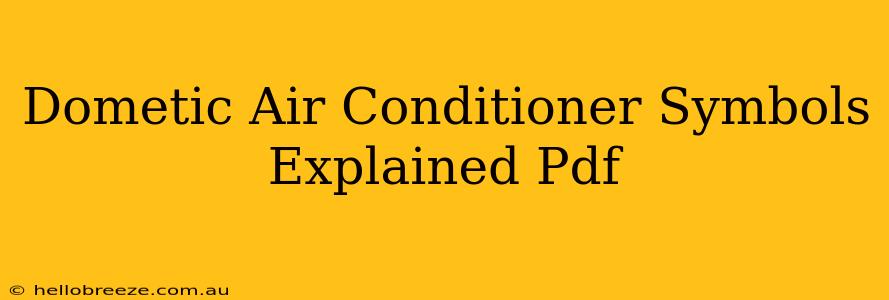Finding the right setting on your Dometic air conditioner can sometimes feel like deciphering a secret code. Those tiny symbols on the control panel can be confusing, especially if you don't have the manual handy. This guide will help you understand the common Dometic air conditioner symbols, ensuring you stay cool and comfortable all season long. We'll break down each symbol clearly, providing a comprehensive explanation to make operating your unit a breeze.
Understanding Your Dometic AC Control Panel: Key Symbols Explained
Dometic air conditioners, known for their reliability and efficiency, utilize a system of symbols to indicate various functions and settings. While specific symbols may vary slightly depending on your model, many are consistent across the Dometic range. Let's dive into some of the most common ones:
Power Symbol:
This is usually depicted as a simple on/off switch symbol or a circle with a line through it to indicate "off". Pressing this button will turn your Dometic AC unit on or off. It's the fundamental control for your system's operation.
Fan Speed Symbol:
You'll likely see symbols representing low, medium, and high fan speeds. These might be indicated by a fan with one, two, or three blades, or by a series of bars increasing in length to denote increasing fan speed. Adjusting the fan speed allows you to customize the airflow to your preference and energy needs.
Mode Selection Symbols:
Dometic AC units often have multiple operating modes:
- Cool: This symbol usually features a snowflake or a stylized icicle. It indicates that the unit is in cooling mode, actively reducing the temperature inside your RV or vehicle.
- Heat: If your unit offers heating, you'll see a symbol representing heat, often a sun or a stylized flame. This activates the heating function, warming the interior space.
- Fan Only: This is typically shown by a fan icon alone, without any additional symbols like a snowflake or flame. This mode circulates air without heating or cooling, useful for ventilation.
- Auto: Some Dometic AC units feature an "Auto" mode. The symbol is usually "Auto" or an abbreviation thereof. In Auto mode, the unit automatically adjusts the cooling or heating based on the set temperature.
Temperature Setting Symbols:
You'll likely see symbols indicating temperature increase (+) and decrease (-). These are crucial for adjusting the desired temperature. These usually take the form of arrows pointing up or down.
Timer Symbol:
A clock icon often signifies a timer function. This allows you to program your Dometic AC unit to turn on or off automatically at a specific time.
Other Potential Symbols:
Depending on your specific Dometic model, you might also encounter symbols for:
- Filter Change Indicator: This might be a light bulb or an icon of a filter. This indicates that the air filter needs cleaning or replacing.
- Error Codes: Various error codes may be displayed, requiring you to consult your Dometic AC manual for troubleshooting. These are typically alphanumeric codes.
Troubleshooting Common Issues
If you're experiencing problems with your Dometic air conditioner, carefully review the symbols on the control panel for any error codes. Consult your user manual for detailed troubleshooting steps. Common issues might include filter clogging, frozen evaporator coils, or electrical problems.
Maintaining Your Dometic Air Conditioner
Regular maintenance is vital for the longevity and efficiency of your Dometic AC unit. This includes regularly cleaning or replacing the air filter and occasionally checking for any signs of malfunction.
By understanding these common Dometic air conditioner symbols, you can efficiently operate and maintain your unit, ensuring a comfortable and enjoyable experience. Remember to always refer to your owner's manual for specific instructions and details pertaining to your model.

